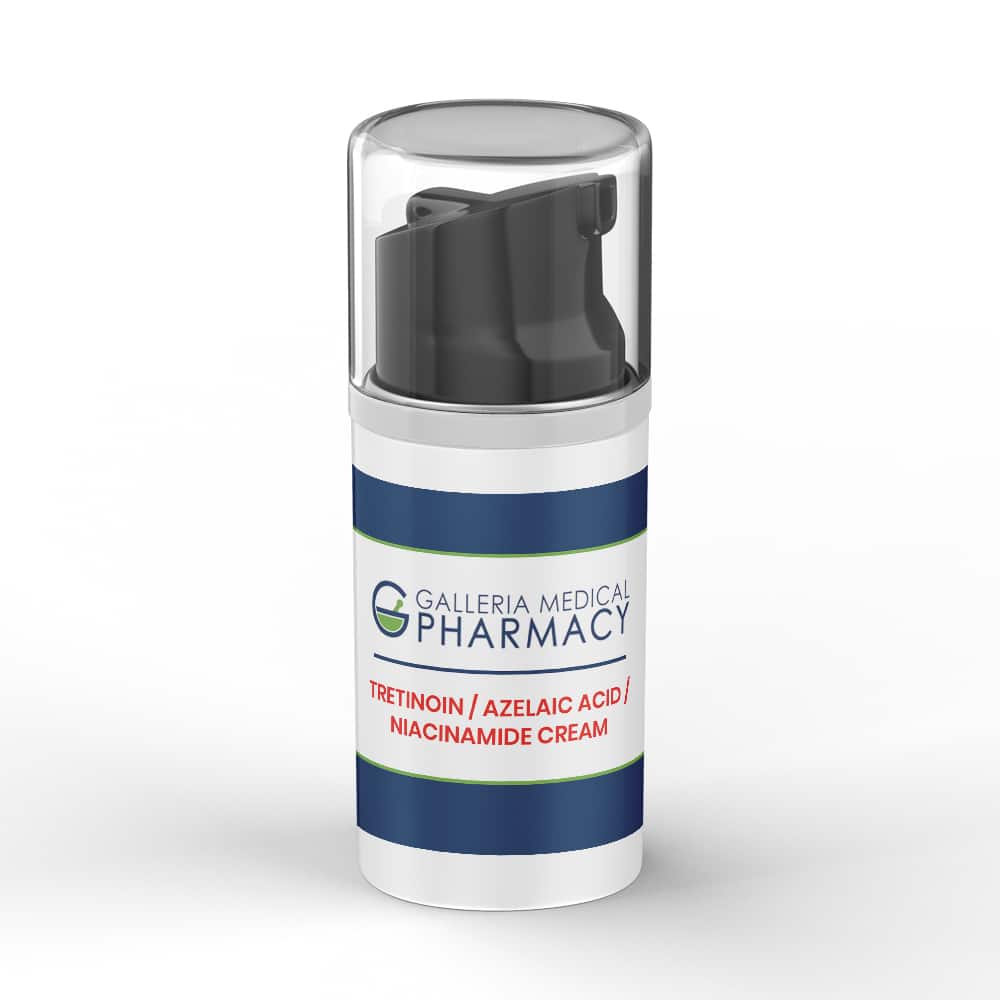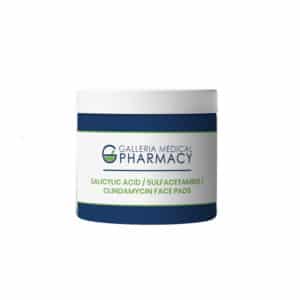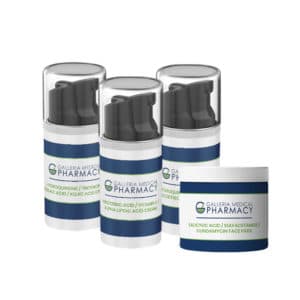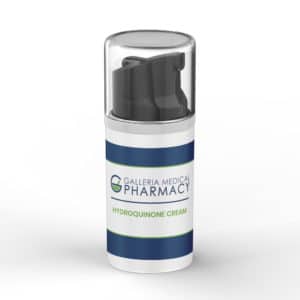Tretinoin / Azelaic Acid / Niacinamide Cream
- Home
- /
- Products
- /
- Acne and Rosacea
- /
- Tretinoin / Azelaic Acid / Niacinamide Cream

Overview
Tretinoin / Azelaic Acid / Niacinamide Cream is a combination of prescription drug products that have been formulated into a hypoallergenic cream to address acne vulgaris as well as rosacea. While mild cases of acne may respond well to over-the-counter treatments, stubborn cases require stronger treatments. It is also difficult to find a single product that is effective in treating both acne vulgaris and rosacea. Combining tretinoin, azelaic acid, and niacinamide into one formulation may increase patient compliance with treatment and improve both conditions. The preparation is applied to the affected area once to twice daily and the ingredients work synergistically together to decrease redness and pimples. Other benefits of the compound may include the reduction of fine lines and wrinkles and the lessening of hyperpigmentation.
Tretinoin
Tretinoin, also called all-trans-retinoic acid (ATRA), is a naturally occurring derivative of vitamin A (or retinol) that increases cell turnover. Tretinoin when applied topically is used to treat mild to moderate acne (e.g., grades I-III), photodamaged skin, and keratinization disorders such as ichthyosis and keratosis follicularis. Topical tretinoin is effective in reducing fine lines, hyperpigmentation, roughness, and laxity associated with photodamaged skin. It clears the skin of blemishes and discolorations by speeding the process of cell renewal.1, 2, 3, 4
Azelaic Acid
Azelaic acid is a naturally occurring substance found in wheat, rye, and barley. It is also produced naturally by a certain fungus found on human skin. Azelaic acid is used topically in the management of acne vulgaris, rosacea and other inflammatory skin conditions. It has been shown to be significantly better at reducing rosacea symptoms than metronidazole. Its mechanism of action is not entirely clear but it is believed to work by killing and stopping new growth of aerobic and anaerobic bacteria. It is generally well tolerated when applied topically, however, mild to moderate itching and dry skin are possible side effects of azelaic acid.5, 6, 7
Niacinamide
Niacinamide is the physiologically active form of niacin (vitamin B3). Found naturally in food (e.g., meat, dairy products, legumes, nuts, seeds, green leafy vegetables, fortified grains, etc.), niacinamide is a precursor of the cofactors niacinamide adenine dinucleotide (NAD) and niacinamide adenine dinucleotide phosphate (NADP). NAD and NADP are key components of many essential metabolic pathways in the human body. Niacinamide holds anti-inflammatory properties and is used topically to manage a variety of skin conditions including bullous pemphigoid, IgA bullous dermatosis, acne vulgaris, and pruritus (itching). Studies have also shown niacinamide’s ability to reduce redness and hyperpigmentation when applied topically.8, 9
Indications
The active ingredients in this preparation are indicated for the topical treatment of inflammatory acne vulgaris. Studies also suggest patients suffering from rosacea would benefit from the active ingredients in this preparation.
How Supplied
At this time, this preparation is not commercially available in the United States as a single product and must be compounded for patients that would benefit from its administration as determined by a prescriber. Common formulations prepared at Galleria Medical Pharmacy include but are not limited to:
Tretinoin 0.015% / Azelaic Acid 4% / Niacinamide 4% Cream
Tretinoin 0.03% / Azelaic Acid 4% / Niacinamide 4% Cream
Tretinoin 0.045% / Azelaic Acid 4% / Niacinamide 4% Cream
Storage
Store this medication at 68°F to 77°F (20°C to 25°C) and away from heat, moisture and light. Keep all medicine out of the reach of children. Throw away any unused medicine after the beyond use date. Do not flush unused medications or pour down a sink or drain.
Reference
- Altreno (tretinoin lotion) package insert; Bridgewater, NJ: Valeant Pharmaceuticals North America LLC; 2018 Aug.
- Renova 0.02% (tretinoin cream) package insert; Bridgewater, NJ: Valeant Pharmaceuticals North America LLC; 2013 Jun.
- Yoham AL, Casadesus D, “Tretinoin”. In: StatPearls [Internet]. Treasure Island (FL): StatPearls Publishing; 2020 Jan-. Available from: https://www.ncbi.nlm.nih.gov/books/NBK557478/
- Fisher GJ, Wang Z, Datta SC, et al. Pathophysiology of premature skin aging induced by ultraviolet light. N Engl J Med 1997;337:1419-28.
- Azelaic acid (Azelex) 20% Cream package insert. Irvine, CA: Allergan Inc.; 2003, Jun.
- “Azelaic acid”, Drug Bank.[Online]. Available: https://go.drugbank.com/drugs/DB00548
- E. Frampton, A. J. Wagstaff, “Azelaic Acid 15% gel in the treatment of papulopustular rosacea”, The American Journal of Clinical Dermatology, vol.5, issue 1, pp. 57 – 64, 2004.
- PC Chiu, CC Chan , HM Lin, HC Chiu, “The clinical anti-aging effects of topical kinetin and niacinamide in Asians: a randomized, double-blind, placebo-controlled, split-face comparative trial”, Journal of Cosmetic Dermatology vol.6, issue 4, pp. 243 -249, December 2007. Available: https://pubmed.ncbi.nlm.nih.gov/18047609/
- Forbat, F. Al-Niaimi, FR. Ali, “Use of nicotinamide in dermatology”, Clinical and Experimental Dermatology vol.42, issue 2, pp. 137 – 144, March 2017. Available: https://pubmed.ncbi.nlm.nih.gov/28052374/
Compounding Pharmacy Statement
This preparation is compounded with drug components whose suppliers are registered with the FDA. While Galleria Medical Pharmacy adheres to USP <795> guidelines and applicable state and federal regulations to meet the required quality standards, the statements made regarding this preparation have not been evaluated by the FDA for safety or clinical effectiveness. As such, this preparation is not intended to diagnose, treat, cure, or prevent any disease. For inquiries concerning this preparation, please contact (504) 267-9876.





